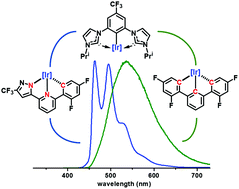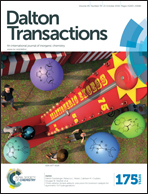Room temperature blue phosphorescence: a combined experimental and theoretical study on the bis-tridentate Ir(iii) metal complexes†
Abstract
A series of new bis-tridentate Ir(III) complexes (1/1b, 2/2b and 3/3b) incorporating both bis(imidazolylidene)benzene and dianionic functional pyrazolyl (or phenyl) pyridine chelates have been synthesized, among which complexes 2 and 2b exhibit intense and structural sky-blue emission in both solution and solid states. In stark contrast, 1/1b is non-emissive in solution, while 3/3b reveals highly red-shifted emission with a featureless spectral profile. This variation in photophysics is associated with the interchange of metal–chelate bonding in the selected tridentate chelate, which affects both the crystal field stabilization energy and the ππ* transition character of the resulting Ir(III) metal complexes. In 1/1b, the stabilized metal-centered (MC) dd excited states induce a dominant radiationless channel that accounts for the lack of emission in solution. The appreciable ligand-to-ligand charge transfer (LLCT) in 3/3b rationalizes its broad and featureless emission, which is different from the dominant intraligand ππ* transition in 2/2b. The combination of experimental and theoretical approaches thus provides fundamental insight into the influence of chelates as well as the metal–chelate interaction, which is beneficial for the future design of efficient and robust Ir(III) phosphors for OLED applications.


 Please wait while we load your content...
Please wait while we load your content...